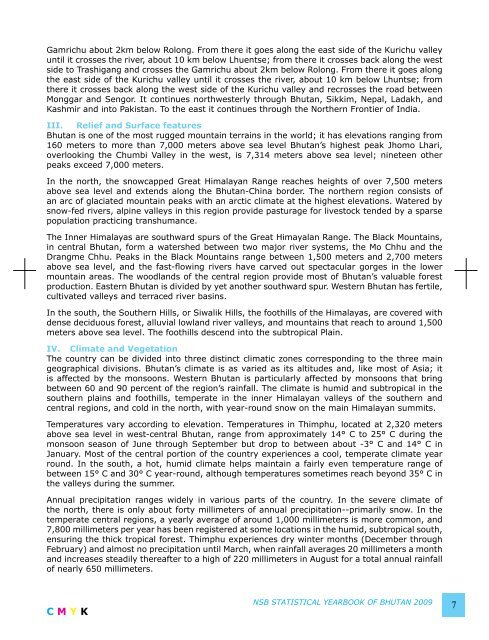National Statistics Bureau - Gross National Happiness Commission
National Statistics Bureau - Gross National Happiness Commission
National Statistics Bureau - Gross National Happiness Commission
Create successful ePaper yourself
Turn your PDF publications into a flip-book with our unique Google optimized e-Paper software.
Gamrichu about 2km below Rolong. From there it goes along the east side of the Kurichu valley<br />
until it crosses the river, about 10 km below Lhuentse; from there it crosses back along the west<br />
side to Trashigang and crosses the Gamrichu about 2km below Rolong. From there it goes along<br />
the east side of the Kurichu valley until it crosses the river, about 10 km below Lhuntse; from<br />
there it crosses back along the west side of the Kurichu valley and recrosses the road between<br />
Monggar and Sengor. It continues northwesterly through Bhutan, Sikkim, Nepal, Ladakh, and<br />
Kashmir and into Pakistan. To the east it continues through the Northern Frontier of India.<br />
III. Relief and Surface features<br />
Bhutan is one of the most rugged mountain terrains in the world; it has elevations ranging from<br />
160 meters to more than 7,000 meters above sea level Bhutan’s highest peak Jhomo Lhari,<br />
overlooking the Chumbi Valley in the west, is 7,314 meters above sea level; nineteen other<br />
peaks exceed 7,000 meters.<br />
In the north, the snowcapped Great Himalayan Range reaches heights of over 7,500 meters<br />
above sea level and extends along the Bhutan-China border. The northern region consists of<br />
an arc of glaciated mountain peaks with an arctic climate at the highest elevations. Watered by<br />
snow-fed rivers, alpine valleys in this region provide pasturage for livestock tended by a sparse<br />
population practicing transhumance.<br />
The Inner Himalayas are southward spurs of the Great Himayalan Range. The Black Mountains,<br />
in central Bhutan, form a watershed between two major river systems, the Mo Chhu and the<br />
Drangme Chhu. Peaks in the Black Mountains range between 1,500 meters and 2,700 meters<br />
above sea level, and the fast-flowing rivers have carved out spectacular gorges in the lower<br />
mountain areas. The woodlands of the central region provide most of Bhutan’s valuable forest<br />
production. Eastern Bhutan is divided by yet another southward spur. Western Bhutan has fertile,<br />
cultivated valleys and terraced river basins.<br />
In the south, the Southern Hills, or Siwalik Hills, the foothills of the Himalayas, are covered with<br />
dense deciduous forest, alluvial lowland river valleys, and mountains that reach to around 1,500<br />
meters above sea level. The foothills descend into the subtropical Plain.<br />
IV. Climate and Vegetation<br />
The country can be divided into three distinct climatic zones corresponding to the three main<br />
geographical divisions. Bhutan’s climate is as varied as its altitudes and, like most of Asia; it<br />
is affected by the monsoons. Western Bhutan is particularly affected by monsoons that bring<br />
between 60 and 90 percent of the region’s rainfall. The climate is humid and subtropical in the<br />
southern plains and foothills, temperate in the inner Himalayan valleys of the southern and<br />
central regions, and cold in the north, with year-round snow on the main Himalayan summits.<br />
Temperatures vary according to elevation. Temperatures in Thimphu, located at 2,320 meters<br />
above sea level in west-central Bhutan, range from approximately 14° C to 25° C during the<br />
monsoon season of June through September but drop to between about -3° C and 14° C in<br />
January. Most of the central portion of the country experiences a cool, temperate climate year<br />
round. In the south, a hot, humid climate helps maintain a fairly even temperature range of<br />
between 15° C and 30° C year-round, although temperatures sometimes reach beyond 35° C in<br />
the valleys during the summer.<br />
Annual precipitation ranges widely in various parts of the country. In the severe climate of<br />
the north, there is only about forty millimeters of annual precipitation--primarily snow. In the<br />
temperate central regions, a yearly average of around 1,000 millimeters is more common, and<br />
7,800 millimeters per year has been registered at some locations in the humid, subtropical south,<br />
ensuring the thick tropical forest. Thimphu experiences dry winter months (December through<br />
February) and almost no precipitation until March, when rainfall averages 20 millimeters a month<br />
and increases steadily thereafter to a high of 220 millimeters in August for a total annual rainfall<br />
of nearly 650 millimeters.<br />
C M Y K<br />
NSB STATISTICAL YEARBOOK OF BHUTAN 2009<br />
7
















